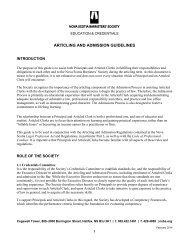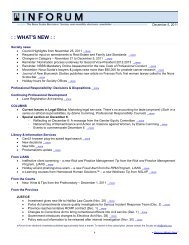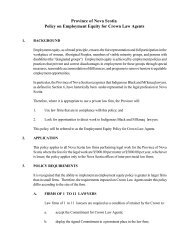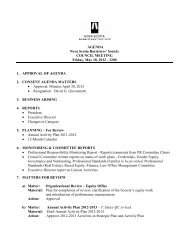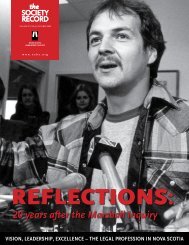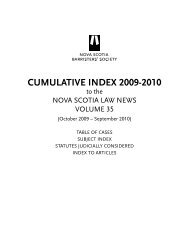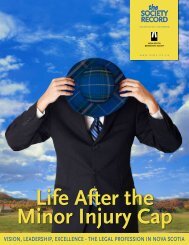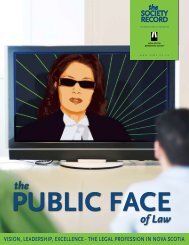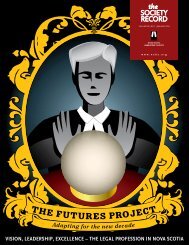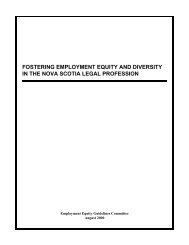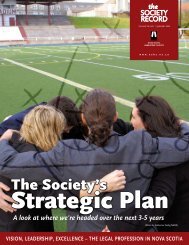SR Vol 25 No 1, January 2007 - Nova Scotia Barristers' Society
SR Vol 25 No 1, January 2007 - Nova Scotia Barristers' Society
SR Vol 25 No 1, January 2007 - Nova Scotia Barristers' Society
You also want an ePaper? Increase the reach of your titles
YUMPU automatically turns print PDFs into web optimized ePapers that Google loves.
You bethejudgeQ:A :Does Small Claims Court need more procedural protection now thatclaims are higher?Informality in Small Claims Courts has traditionallybeen justified on the basis that “Cadillac-styleprocedures are not needed to process bicycle-sizedlawsuits.” In <strong>No</strong>va <strong>Scotia</strong>’s Small Claims Court,forms can be filled out by hand, there is no process for pre-trialdisclosure, the rules of evidence are relaxed, and hearings are notrecorded. Appeals are limited to errors of law or jurisdiction, ordenials of natural justice. Streamlined procedures make the processlightning-fast by litigation standards: the time from filing a claim totrial is usually only a matter of weeks.the Small Claims process.According to those whostudy such things, few selfrepresentedlitigants say theyCynthia ChewterBarrister & Solicitorwould prefer greater formality at hearings. Self-reps say they wanta process that (a) doesn’t cost them too much money, (b) proceedsrelatively quickly, (c) is easy to understand, (d) gives them a chanceto say their piece, and (e) involves an adjudicator they regard asindependent and fair-minded. To that end, here are some reformsthat would enhance fairness in our smallest and fastest of courts:Back in 1981, when the Small Claims Court had a $3,000 limit,informal procedures made good sense. But the current monetary limitof the Small Claims Court is $<strong>25</strong>,000. Along with British Columbia,Alberta and the Yukon, we now have the highest monetary limit ofany Small Claims Court in <strong>No</strong>rth America, but our court’s rules andprocedures – what few there are – are still bicycle-sized.This is a problem. For example, in Kemp v. Prescesky, [2006] N.S.J. <strong>No</strong>.174; 2006 NSSC 122 (S.C.), the defendants had just two weeks afterservice of the claim to learn the Court’s procedures, file their defence andprepare their case for trial. Justice Warner concluded that justice thisspeedy is “fundamentally unfair” in part because the $<strong>25</strong>,000 monetarylimit now exceeds the average gross annual income in <strong>No</strong>va <strong>Scotia</strong>. Abasic tenet of natural justice is that the more there is at stake, the greaterthe level of procedural safeguards required to ensure fairness.I am not advocating that we impose the Civil Procedure Rules on(a) The proceedings must be recorded. We record proceedingsover a $<strong>25</strong> parking ticket but not a $<strong>25</strong>,000 negligence claim.Adjudicators regularly hear matters that take the equivalent oftwo or three days of trial time. Justice should not depend on thecomprehensiveness of the adjudicator’s notes.(b) The rules should provide for mandatory pre-trial disclosureof documents, exhibits, and the anticipated evidence ofwitnesses, well in advance of the hearing. Contact informationfor all witnesses should be exchanged. If expert evidence is to becalled (a common occurrence), an expert’s report should be filedalong with a summary of the expert’s qualifications. This is theonly way to eliminate trial by ambush.(c) The rules should provide a way to set aside a judgmentgranted in the defendant’s absence on the same basis as adefault judgment obtained in the Supreme Court. Justice32 The <strong>Society</strong> Record



